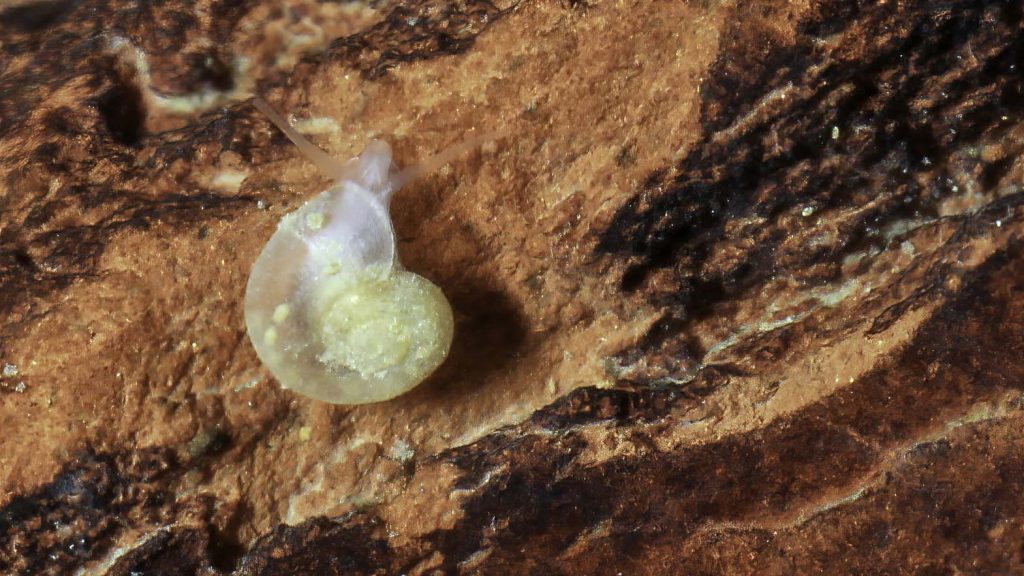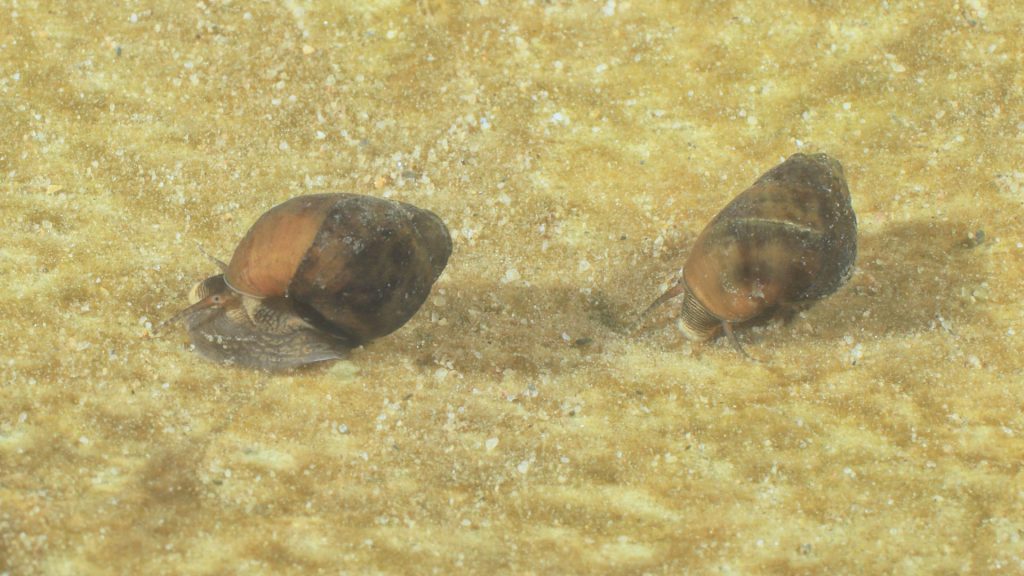October’s 12 Months of Alabama Aquatic Critters will focus on one of the smaller species found in the State’s waters…aquatic snails!
Freshwater snails are the “janitors” of the water, grazing on algae and dead plant matter from underwater substrate. Snails have an important role in the food chain, providing meals for crayfish, turtles, fish, and waterfowl.
Dr. Paul Johnson with the Alabama Aquatic Biodiversity Center noted that Alabama is home to approximately 210 freshwater snail species. With such a diversity of species, we are only able to highlight a few, but you can view a more comprehensive list on the Outdoor Alabama website by the Alabama Department of Conservation and Natural Resources.

Aquatic snails, along with mussels, are part of the phylum Mollusca along, which we covered earlier this year. More specifically, snails are part of the taxonomic group Gastropoda, or gastropods, which includes slugs, limpets, and other organisms.
There are distinct characteristics that help us classify and identify different snails. Gastropods were traditionally classified into four subclasses; Opisthobranchia (gills to the right and behind the heart), Gymnomorpha (slugs, no shell), Prosobranchia (gills in front of the heart), and Pulmonata (lungs instead of gills).
Snails can be further classified by whether they are “left-handed” (sinistral) or “right-handed” (dextral). You can determine this by holding the snail with its point facing upwards and the opening (aperture) facing towards you.
Other identifying characteristics include their shell color, size and shape of body whorls and spire, type of umbilicus, the presence and type of an operculum, and the direction of the opening or aperture.

Life Cycle
While some aquatic snails birth live young (Family Viviparidae), most snails lay eggs. Female snails typically lay their eggs in submerged aquatic plants, rocks, or woody debris. Several species of snails lay eggs in gelatinous capsules, or clutches, which can contain just a couple to hundreds of eggs and vary in color.
Embryos develop inside the eggs, taking up nutrients to grow into tiny snails before they hatch. The timeframe of this stage varies depending on the species of snail and environmental factors such as temperature and nutrient availability.
Juvenile snails hatch from the eggs once they have developed adequately and continue to take in nutrients to develop their shells and bodies. Adult snails can reach maturity within a matter of months or over a year.
Check out the videos below for a look into the life cycles of freshwater snails.
Brewer’s Cavesnail
Known by many names, including Brewer’s Cavesnail and Manitou Cavesnail, Antrorbis breweri is endemic to (found only) in Manitou Cave in DeKalb County, Alabama. The species is named for a former owner of the cave, Dr. Stephen Brewer. The cave is protected by the Manitou Cave of Alabama, Inc through which you can request a visit.

Freshwater Periwinkles
Freshwater Periwinkles include Alabama Horn, River, and Rock snails. Below are just a few species of Periwinkles in Alabama.
The Smooth Mudalia (Leptoxis virgata) is endemic to the Tennessee River Basin and primarily prefers shoal habitats. Its populations were drastically diminished after the construction of several dams, including the Guntersville Dam, in North Alabama.

The Coldwater Elimia (Elimia modesta) are common along the Coosa River in Alabama and Georgia. Their shells are dark brown with tan-brown lines along the whorls.

Silty Hornsnails (Pleurocera canaliculata) can be distinguished by their elongated bodies and alternating yellow and brown stripes. They are common in the Tennessee River Basin.

Painted Rocksnail
Painted rocksnail (Leptoxis coosaensis) are fairly small, growing less than an inch long, restricted to the Coosa River Basin in Calhoun, Chilton, Shelby, and Talladega Counties. Their shells are yellow to olive-brown with bands along its whorls.
They lay tan-colored eggs on rocks just under the waterline, and use mucus to protect them. Painted rocksnails graze on algae and dead plant matter, helping keep the water clean.

Pouch Snails
Pouch snails are of the Order Basommatophora, which is a suborder of Pulmonata, meaning they have lungs instead of gills. The use of lungs instead of gills makes it so they are not dependent on dissolved oxygen in the water, therefore can live in lower quality waterbodies. Alabama has at least five species of pouch snails which are commonly found throughout most in Alabama waters.
Tulotoma Snail
Tulotoma (Tulotoma magnifica) snails are part of a group of live-bearing snails. The Tulotoma snail was once abundant in the Alabama River, however populations sharply declined due to habitat destruction and the impoundment of the Alabama and Coosa River systems. The U.S. Fish and Wildlife Service has implemented rigorous restoration efforts that have helped the species to survive.

Tulotoma snails birth “fully formed young” that remain in the female until they are developed enough to survive in the water. They feed on algae, bacteria, and other suspended solids in the water column and on rocks.
Threats
Invasive Species
The Amazonian Apple Snail, also known as Island Apple Snail, (Pomacea maculata) is an invasive, nuisance species. As the name indicates, the Amazonian Apple Snail is native to South America and is well-known for its bright pink egg casings. This apple snail can grow up to 4 inches, and like the non-invasive Florida Apple Snail, has a yellow-brown shell, which makes them difficult to distinguish.
Amazonian Apple Snails damage crops and out-compete native wildlife for food and resources, which can have a significant negative impact on the marsh ecosystems they inhabit. The Mobile Bay National Estuary Program leads initiatives, along with other coastal groups, for removing invasive apple snails from Alabama’s shores.
The Florida Apple Snail (Pomacea paludosa) is native to the Gulf Coast of Florida and Alabama but you may be unlikely to come across them. They are similar in appearance to the Amazonian Apple Snail but lay white eggs as opposed to bright pink.

Water Quality
Freshwater snails are dependent on good water quality for their diets, reproductive cycles, and the formation and strength of their shells. Factors like pH, alkalinity and hardness can impact shell formation, as they depend on a certain amount of calcium in the water.
Habitat destruction and impoundment of rivers through the construction of dams have caused and will continue to cause declines in populations if restoration efforts are not implemented.
You can find detailed information about the snail species found in Alabama at outdooralabama.com/aquatic-snails/.
Do you have photos or videos of freshwater snails? If so, share them with us using the AWW Photo/Video Submission form.

I found this specimen in Muddy Creek in Mobile County, Alabama.